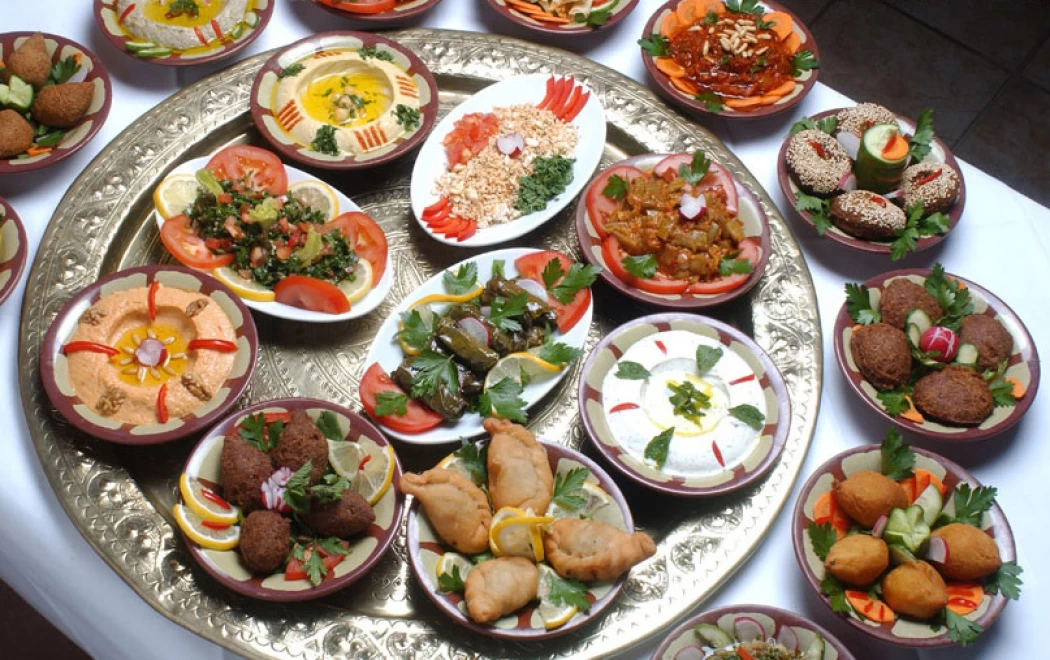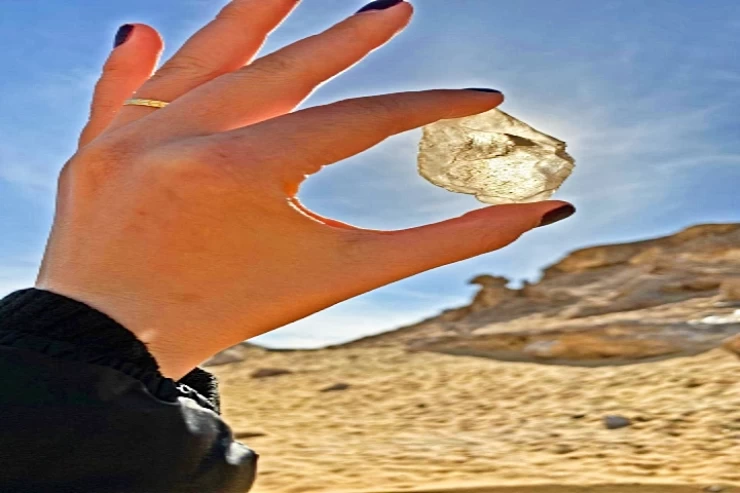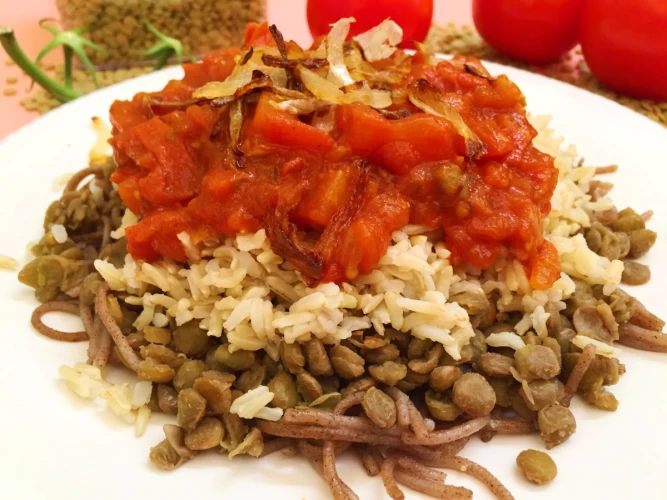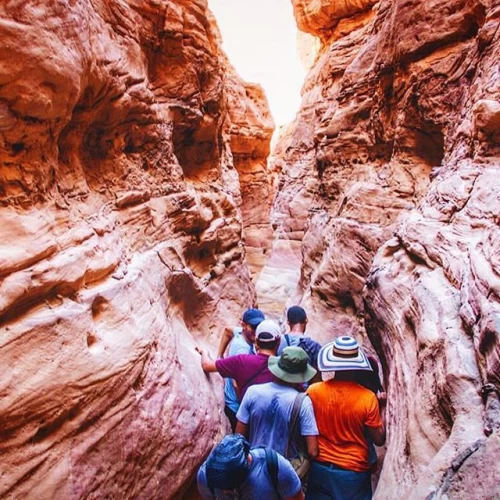
Cocina Egipcia/ Gastronomía de Egipto
La cocina egipcia hace un uso intensivo de legumbres, verduras y frutas del rico valle del Nilo y delta de Egipto. Comparte similitudes con los alimentos de la región del Mediterráneo Oriental, como verduras rellenas de arroz, hojas de uva, shawerma, kebab y kofta. Ejemplos de platos egipcios incluyen ful medames, puré de habas; kushari, lentejas y pasta; y molokhiya, estofado de quingombó. El pan de pita, conocido localmente como eish baladi, y la fabricación de queso en Egipto se remontan a la Primera Dinastía de Egipto, y la domty es el tipo de queso más popular que se consume en la actualidad .
Las carnes comunes en la cocina egipcia son conejo, paloma, pollo y pato. El cordero y la carne se usan con frecuencia para asar a la parrilla. Los despojos son una comida rápida popular en las ciudades, y el foie gras es un manjar que se ha preparado en la región desde al menos 2500 a. C. Los pescados y mariscos son comunes en las regiones costeras de Egipto. Una cantidad significativa de la cocina egipcia es vegetariana, debido tanto al precio históricamente alto de la carne como a las necesidades de la comunidad cristiana copta, cuyas restricciones religiosas requieren dietas esencialmente veganas durante gran parte del año.
El té es la bebida nacional de Egipto, y la cerveza es la bebida alcohólica más popular. Mientras que el Islam es la fe mayoritaria en Egipto y los musulmanes observantes tienden a evitar el alcohol, las bebidas alcohólicas todavía están disponibles en el país.
Los postres populares en Egipto incluyen baqlawa, basbousa y kunafa. Los ingredientes comunes en los postres incluyen dátiles, miel y almendras.
La cocina egipcia es notablemente propicia para las dietas vegetarianas, ya que depende en gran medida de las legumbres y los platos de verduras. Aunque la comida en Alejandría y la costa de Egipto tiende a utilizar una gran cantidad de pescado y otros mariscos, en su mayor parte, la cocina egipcia se basa en alimentos que crecen en la tierra.
Los puertos egipcios del Mar Rojo fueron los principales puntos de entrada para las especias a Europa. El fácil acceso a diversas especias, a lo largo de los años, ha dejado su huella en la cocina egipcia. El comino es la especia más utilizada. Otras especias comunes incluyen cilantro, cardamomo, chile, anís, laurel, eneldo, perejil, jengibre, canela, menta y clavo.
Las carnes comunes que aparecen en la cocina egipcia son el conejo, la paloma, el pollo y el pato. A menudo se hierven para hacer el caldo de varios guisos y sopas. El cordero y la carne de res son las carnes más comunes utilizadas para asar a la parrilla. Las carnes a la parrilla como kofta , kabab y chuletas a la parrilla se denominan categóricamente mashwiyat .
Los despojos, variedad de carnes, son populares en Egipto. Los sándwiches de hígado, una especialidad de Alejandría, son una comida rápida popular en las ciudades. Los trozos de hígado picados fritos con pimientos, chile, ajo, comino y otras especias se sirven en un pan tipo baguette llamado eish fino. El cerebro de vaca y oveja se come en Egipto.
El foie gras, un manjar bien conocido, todavía lo disfrutan hoy los egipcios. Su sabor se describe como rico, mantecoso y delicado, a diferencia del de un hígado de pato o de ganso ordinario. El foie gras se vende entero o se prepara en mousse, parfait o paté, y también se puede servir como acompañamiento de otro alimento, como un filete. La técnica implica la deglución, abarrotar alimentos en la garganta de patos y gansos domesticados, y se remonta al año 2500 a. C., cuando los antiguos egipcios comenzaron a criar aves para comer.
Cocina y práctica religiosa:
Aunque el Ramadán es un mes de ayuno para los musulmanes en Egipto, generalmente es un momento en que los egipcios prestan mucha atención a la variedad y riqueza de alimentos, ya que romper el ayuno es un asunto familiar, a menudo con familias enteras reunidas en la mesa justo después. puesta de sol. Hay varios postres servidos casi exclusivamente durante el Ramadán, como kunafa y qatayef . En este mes, muchos egipcios preparan una mesa especial para los pobres o transeúntes, generalmente en una tienda de campaña en la calle, llamada Ma'edet Rahman (árabe egipcio: que literalmente se traduce como "Mesa del Misericordioso", refiriéndose a uno de los 99 nombres de Dios en el Islam. Estos pueden ser bastante simples o lujosos, dependiendo de la riqueza y la ostentación del proveedor.
Los cristianos observantes en Egipto se adhieren a los períodos de ayuno según el calendario copto; Estos pueden extenderse prácticamente a más de dos tercios del año para los más extremos y observadores. La población copta más secular ayuna principalmente solo en Semana Santa y Navidad. La dieta copta para el ayuno es esencialmente vegana. Durante este ayuno, los coptos suelen comer verduras y legumbres fritas en aceite y evitan la carne, el pollo y los productos lácteos, como la mantequilla y la nata.
Bebidas:
El té es una parte vital de la vida cotidiana y la etiqueta popular en Egipto. Por lo general, acompaña el desayuno en la mayoría de los hogares, y beber té después del almuerzo es una práctica común. Visitar el hogar de otra persona, independientemente del nivel socioeconómico o el propósito de la visita, implica una taza de té obligatoria; Se podría requerir una hospitalidad similar para una visita de negocios a la oficina privada de alguien lo suficientemente rico como para mantener una, dependiendo de la naturaleza del negocio. Un apodo común para el té en Egipto es "deber" (pronunciado en árabe como "wa-jeb" o "wa-geb"), ya que servir té a un visitante se considera un deber, mientras que cualquier cosa más allá es algo agradable.
El café , ahwa árabe egipcio: se considera parte de la bienvenida tradicional en Egipto. Por lo general, se prepara en una pequeña cafetera, que se llama dalla o kanakah en Egipto. Se sirve en una pequeña taza hecha para café llamada fengan . El café generalmente se endulza con azúcar en varios grados; 'al riha, mazbout y ziyada respectivamente. El café sin azúcar se conoce como sada o simple.
En Egipto, el jugo de caña de azúcar se llama aser asab y es una bebida increíblemente popular servida por casi todos los vendedores de jugos de frutas, que se pueden encontrar en abundancia en la mayoría de las ciudades.
Los tés de regaliz y las bebidas de jugo de algarroba se disfrutan tradicionalmente durante el mes islámico del Ramadán, al igual que amar al-din, una bebida espesa hecha reconstituyendo láminas de albaricoque seco con agua. Las sábanas se consumen a menudo como dulces. Sobia es otra bebida que se sirve tradicionalmente durante el Ramadán. Es una bebida dulce de leche de coco, generalmente vendida por vendedores ambulantes.
Una bebida agria y fría hecha de tamarindo es popular durante el verano llamada tamr hindi Literalmente se traduce como "Fechas indias", que es el nombre árabe para tamarindo.
Tenemos las mejores ofertas y ofertas para que disfrute de una variedad de viajes y vacaciones clásicos de Egipto, viajes privados de presupuesto a Egipto y paquetes de viaje a Egipto para satisfacer todos sus sueños sobre el antiguo Egipto, la cuna de las civilizaciones, lo ayudaremos a planificar sus paquetes clásicos a Egipto y cubren la mayor parte de la tierra de los faraones, luego le dejaremos probar la más alta calidad de servicio de viaje ofrecido por los guías de . Reserve ahora para una gran experiencia de vacaciones en Egipto y paquetes de vacaciones en Egipto para visitar la increíble Giza. pirámides y la esfinge, el museo egipcio, el valle de los reyes, el Cairo copto e islámico, así como el templo de Abu Simbel y todas las maravillas del antiguo Egipto. Nuestro especialista en egiptología le proporcionará amplia información sobre la historia egipcia o los lugares históricos.
Culinary Expeditions in Egyptian Food: History and Gastronomy in One Buffet
Each nation has its specialties and recipes that draw from time, culture, geography, and so on, and Egypt is not an anomaly in that order. Egyptian food culture has existed and flourished for thousands of years, and their culinary practices may constitute the simplest of natural ingredients, but they have always been rich and flavorful. Whether swirling through the street markets of Cairo, having seemed more exotic than any empire’s cuisine while dining by the Nile, or tucking into the home-cooked food of relatives in a village in Egypt, one finds the thrill of finding new and exciting combinations of flavors and cuisines in the Egyptian culinary experience, which is also home to wondrous sights.
We can begin from the very first Egyptian bread ovens installed by the Pharaohs and come to the kitchens of today. This only goes to show that Egyptian food is very traditional but at the same time takes in a lot from Italy, the Middle East, Africa, and other places. Now let’s get ready for exploration—culinary exploration to be more exact—and examine the unique features, typical cuisine, and role of eating in Egypt.
A Historical Feast: The Origins of Egyptian Cuisine
The history of food in Egypt dates back to the Pharaoh's time. This is because ancient Egyptians played a great role in agriculture, growing wheat, barley, vegetables, and fruits along the banks of the Nile, which was very fertile. The making of bread was integral to the people, and learning to bake bread is among the oldest culinary practices in Egypt. On tomb paintings and hieroglyphs, images of an intact banquet consisting of bread, fish, meat, fruits, and beer are illustrated, which indicates the significance of food in ancient Egypt.
Throughout the ages, Egypt’s culinary art has changed due to many factors over the centuries. For instance, the Greeks, the Romans, and many other civilizations including the Ottomans and Arabs had a role in these changes. Each civilization made contributions in one way or another, bringing along new herbs, cooking methods, and food elements that fused with the ethnic culture of the region to give rise to the effective and delicious cuisine that we have nowadays.
The cuisine of Egypt is characterized by the use of uncomplicated and healthy ingredients, most of which are produced in Egypt itself. Here are some of the main elements that are central to the practice of cooking in Egypt:
Fava beans (ful): Fava beans are one of the most popular ingredients in Egypt, featuring in full, another traditional dish in which fava beans are stewed, and taameya, or Egyptian falafel.
Bread (Aish Baladi): In every Egyptian meal, there is bread included. The most familiar is called aish baladi, which is a circular flatbread made from whole wheat flour slightly thicker than pita and used extensively. It is used to scoop food, wrap around food, and with many other dishes.
Rice: In Egyptian culture, rice is often served as a side dish and is usually exceptional to dishes like gumbo, grilled dishes, or loaded up with other ingredients and spices.
Lentils: The lentil pulse is popular and often used in many Egyptian plates; for example, these include soups, stews, and kosher.
Herbs and spices: One of the main reasons is that most of the food is also full of warm and earthly favors. So, fresh herbs like cilantro, parsley, dill, and spices like cumin, garlic, cinnamon, and turmeric are often added in cooking.
Molokhia: Another quintessential favorite from Egypt is molokhia, which is derived from a green leafy plant with a warm and gooey texture served as a garlicky soup and eaten with rice or bread.
Within Egypt's extensive history, there exists an array of Egyptian dishes that are quite distinct from one another. Thick hearty stews, deep-fried street snacks, and sugary desserts that provide warmth—there is something for everyone. Below are some of the primary dishes that typify the Egyptian food culture:
1. Ful Medames: The National Dish of Egypt
Ful medames, or farinaceous porridge, as it is better known, is a delicious, rich food consisting of seasoned, slow-cooked fava beans with olive oil, lemon, garlic, and cumin. Normally it is taken for breakfast with additional healthy foods such as fresh bread and eggs and some other vegetables like tomato, onion, and cucumber. Being Egyptian national food, it is highly appreciated by residents, and clearly for the tourists, it is a must-dish. This uncomplicated and delicious it has been part of culinary history for many generations, even from Pharaoh’s reign.
2. Taameya: Egyptian Falafel
Globally referred to as felafel, the taameya is the Egyptian equivalent of this popular street food. Unique to the Egyptian version of taameya is the use of fava beans instead of chickpeas to prepare also lighter, airier, and fluffier balls than the rest. Light, crispy, and deep-fried golden brown fritters flavored with herbs—coriander and parsley—would usually be sandwiched in between tahini, salad, and pickles. Taameya can be eaten as a snack or consumed as a meal, and it will prove hard to resist for anyone who tries it.
3. Koshari: The King of Street Food
The most popular street food in Egypt is kosher. Meaning “a mixture,” comfort comes naturally wherever this staple meal type exists. Koshari consists of rice, lentils, macaroni, and chickpeas, which are further topped with a delicious tangy tomato sauce as well as crunchy fried onions and spicy garlic vinegar. Due to its filling properties and inexpensive price, this carbohydrate-rich food entices every Egyptian citizen across all strata. Although kosher boasts simple and cheap ingredients, the dish is a complex jumble of flavor and texture and is highly seasoned.
4. Molokhia: A Green, Garlicky Delight
One of the first food experiences that leaves visitors to Egypt oftentimes unprepared is the strangely tasty and textured dish called Molokhia. The dish consists of cooked mookhia leaves (which are the jute leaves), blended with garlic and coriander to make an edible green paste. This dish is often served together with rice or a dish called aish baladi (Egyptian bread) and is sometimes eaten with chicken, rabbit, or beef. The slimy feel of the dish may take some getting used to, but it is a treasured dish among the Egyptians because of the comfort it brings along with the flavor of the dish, which is not normalized.
5. Mahshi: stuffed vegetables
Mahshi is a common term for toppings stuffed into vegetables such as zucchinis, peppers, or grape leaves that contain rice, spices, and sometimes meat. The stuffing is the center of having tomatoes, onions, and all the spices, which results in the rich and interesting taste of the dish. Mahshi is often cooked on holidays and parties due to the time and effort invested in cooking it. This dish consists of tender soft vegetables in every bite filled with aromatic rice, making it a perfect yummy comfort food back home in Egypt.
6. Fattah: A Festive Feast
Fatet, located in the middle of the plate, is a celebratory platter put together only on rare occasions, such as wedding parties or religious festivities. It consists of crisp, deep-fried bread pieces, rice, and stewed meat, all drenched in vinegar and garlic sauce. The way of serving and eating changes as the dish is filled with broth, resulting in a sumptuous and rich dish that fills one's stomach. In Egyptian traditions, Fattah connotes plenty and refreshment and is thus served and savored on occasions such as feasts and family get-togethers.
7. Hawawshi: Egyptian Meat Pie
Ful medames is a popular street food in Egypt made from boiled fava beans seasoned with olive oil, salt, and cumin. Hawawshi can be considered the Egyptian version of a meat pie. Ground, spiced, and cooked meat, often combined with vegetables and will almost always contain herbs, is present in a pocket of pita bread and oven-baked. The end product is a very sumptuous, tasty, and moist filling beautifully enveloped in a crisp crust. Hawawshi is well-loved by many as a street bite and is ideal for snacking in a hurry or for a quick lunch.
And no exploration of Egyptian gastronomy would be seen as if without having a taste out of its sweetest part. Egyptian sweets are heavy and rich, loaded with nuts, honey, and spices. Below are some of the famous confections found in the native country:
Basbousa: Syrup cake garnished with either almond or coconut. In Egypt, this sweet, moist cake is symbolic of festivities, and it is served in almost all functions.
Konafa: Pestilious stuffing of nuts, cream, or cheese, prohibitively sweetened and layered in a cake made of a very thin chick pastry rolled into slippery threads. In many Arabic countries, konafa is served during the holy month of Ramadan and other feasts.
Om Ali: Egyptian pudding made of layers of marinated and baked phyllo dough and milk with nuts, raisins, and spices. This rich and hearty dessert is usually prepared during festive occasions like family gatherings and cultural events.
Shai is among the beverages that are most enjoyed in various aspects of life in Egypt, more so in gatherings. It is typical for the Egyptians to consume tea without milk, sweetened with sugar, or flavored with a bit of mint. In the case of many Egyptians, tea is not just another drink but an intricate cultural aspect because it represents hospitality and relaxation, especially after a heavy meal or while engaged in social activities with friends. In addition to tea, Karkadeh, which can be referred to as hibiscus tea in English, is another beverage well appreciated in Egypt characterized by its unbelievable red color and a tasty sourness.


















